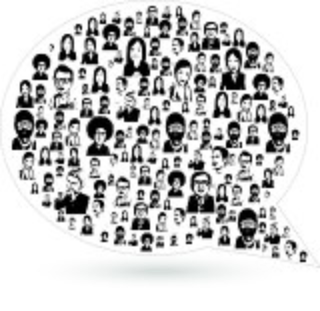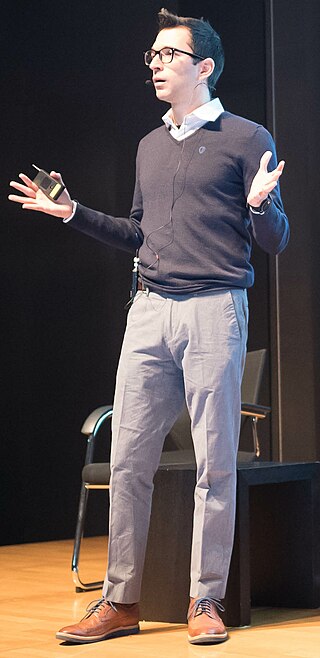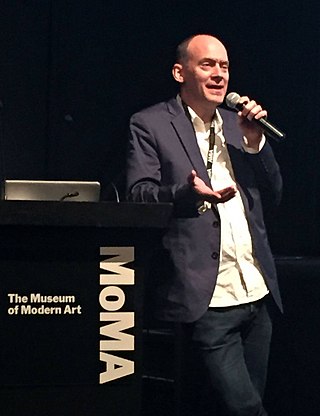Related Research Articles
Collaborative intelligence characterizes multi-agent, distributed systems where each agent, human or machine, is autonomously contributing to a problem solving network. Collaborative autonomy of organisms in their ecosystems makes evolution possible. Natural ecosystems, where each organism's unique signature is derived from its genetics, circumstances, behavior and position in its ecosystem, offer principles for design of next generation social networks to support collaborative intelligence, crowdsourcing individual expertise, preferences, and unique contributions in a problem solving process.
Social bookmarking is an online service which allows users to add, annotate, edit, and share bookmarks of web documents. Many online bookmark management services have launched since 1996; Delicious, founded in 2003, popularized the terms "social bookmarking" and "tagging". Tagging is a significant feature of social bookmarking systems, allowing users to organize their bookmarks and develop shared vocabularies known as folksonomies.

In information systems, a tag is a keyword or term assigned to a piece of information. This kind of metadata helps describe an item and allows it to be found again by browsing or searching. Tags are generally chosen informally and personally by the item's creator or by its viewer, depending on the system, although they may also be chosen from a controlled vocabulary.
Amazon Mechanical Turk (MTurk) is a crowdsourcing website with which businesses can hire remotely located "crowdworkers" to perform discrete on-demand tasks that computers are currently unable to do as economically. It is operated under Amazon Web Services, and is owned by Amazon. Employers post jobs known as Human Intelligence Tasks (HITs), such as identifying specific content in an image or video, writing product descriptions, or answering survey questions. Workers, colloquially known as Turkers or crowdworkers, browse among existing jobs and complete them in exchange for a fee set by the employer. To place jobs, the requesting programs use an open application programming interface (API), or the more limited MTurk Requester site. As of April 2019, Requesters could register from 49 approved countries.
Human-based computation (HBC), human-assisted computation, ubiquitous human computing or distributed thinking is a computer science technique in which a machine performs its function by outsourcing certain steps to humans, usually as microwork. This approach uses differences in abilities and alternative costs between humans and computer agents to achieve symbiotic human–computer interaction. For computationally difficult tasks such as image recognition, human-based computation plays a central role in training Deep Learning-based Artificial Intelligence systems. In this case, human-based computation has been referred to as human-aided artificial intelligence.

Crowdsourcing involves a large group of dispersed participants contributing or producing goods or services—including ideas, votes, micro-tasks, and finances—for payment or as volunteers. Contemporary crowdsourcing often involves digital platforms to attract and divide work between participants to achieve a cumulative result. Crowdsourcing is not limited to online activity, however, and there are various historical examples of crowdsourcing. The word crowdsourcing is a portmanteau of "crowd" and "outsourcing". In contrast to outsourcing, crowdsourcing usually involves less specific and more public groups of participants.
A human-based computation game or game with a purpose (GWAP) is a human-based computation technique of outsourcing steps within a computational process to humans in an entertaining way (gamification).
Human flesh search engine is a Chinese term for the phenomenon of distributed researching using Internet media such as blogs and forums. Internet media, namely dedicated websites and Internet forums, are in fact platforms that enable the broadcast of request and action plans concerning human flesh search and that allow the sharing of online and offline search results. Human flesh search has two eminent characteristics. First, it involves strong offline elements including information acquisition through offline channels and other types of offline activism. Second, it always relies on crowdsourcing: web users collaborate to share information, conduct investigations, and perform other actions concerning people or events of common interest.
Crowd computing is a form of distributed work where tasks that are hard for computers to do, are handled by large numbers of humans distributed across the internet.

Figure Eight was a human-in-the-loop machine learning and artificial intelligence company based in San Francisco.
Citizen sourcing is the government adoption of crowdsourcing techniques for the purposes of (1) enlisting citizens in the design and execution of government services and (2) tapping into the citizenry's collective intelligence for solutions and situational awareness. Applications of citizen sourcing include:

Gamification is the strategic attempt to enhance systems, services, organizations, and activities by creating similar experiences to those experienced when playing games in order to motivate and engage users. This is generally accomplished through the application of game design elements and game principles in non-game contexts.
Microwork is a series of many small tasks which together comprise a large unified project, and it is completed by many people over the Internet. Microwork is considered the smallest unit of work in a virtual assembly line. It is most often used to describe tasks for which no efficient algorithm has been devised, and require human intelligence to complete reliably. The term was developed in 2008 by Leila Chirayath Janah of Samasource.
Government crowdsourcing is a form of crowdsourcing employed by governments to better leverage their constituents' collective knowledge and experience. It has tended to take the form of public feedback, project development, or petitions in the past, but has grown to include public drafting of bills and constitutions, among other things. This form of public involvement in the governing process differs from older systems of popular action, from town halls to referendums, in that it is primarily conducted online or through a similar IT medium.

The gamification of learning is an educational approach that seeks to motivate students by using video game design and game elements in learning environments. The goal is to maximize enjoyment and engagement by capturing the interest of learners and inspiring them to continue learning. Gamification, broadly defined, is the process of defining the elements which comprise games, make those games fun, and motivate players to continue playing, then using those same elements in a non-game context to influence behavior. In other words, gamification is the introduction of game elements into a traditionally non-game situation.

Iyad Rahwan, is a Syrian-Australian scientist. He is the director of the Center for Humans and Machines at the Max Planck Institute for Human Development. Between 2015 and 2020, he was an associate professor of Media Arts & Sciences at the MIT Media Lab. Rahwan's work lies at the intersection of the computer and social sciences, where he has investigated topics in computational social science, collective intelligence, large-scale cooperation, and the social aspects of artificial intelligence.

Todd Lawrence Carter is an American technology entrepreneur. He is best known as the CEO of the New York City-based technology startup company Tagasauris that he co-founded in December 2010.
Crowdsource is a crowdsourcing platform developed by Google intended to improve a host of Google services through the user-facing training of different algorithms.
Lora Aroyo is a Dutch computer scientist at Google Research, and formerly a professor at The Vrije Universiteit Amsterdam, Netherlands. She is best known for her work in user modeling, digital humanities, and for the CrowdTruth crowdsourcing method. She was the founding head of the user-centric data science (UCDS) research group in the VU Computer Science department, president of the User Modeling Society, a former vice-president of Semantic Technology Institute, Chief Scientist at Tagasauris, and a member of over 100 scientific program committees and editorial boards. She was one of the few female full professors of Computer Science in the Netherlands, and her departure to Google leaves only one woman at the VU.
References
- ↑ Bud Mathaisel and Galen Gruman. Getting past the hype of gamification PWC Technology Forecast (Fall 2012).
- ↑ Estrin, James. "Crowd-Sourcing the Magnum Archive" New York Times (July 26, 2011).
- ↑ Russeth, Andrew. "Good Morning! Creative Thinking Edition" New York Observer (August 29, 2011).
- ↑ "Magnum appelle à "taguer" ses archives" Le Monde (August 15, 2011)(in French)
- ↑ Jarvis, Alice-Azania "Who, what, where? Magnum is hoping the modern crowd will help them identify a historic archive" The Independent (August 5, 2011)
- ↑ Grundvig, James Graphing the Spillway of Big Data: Interview With Tagasauris CEO Todd Carter Huffington Post. (October 17, 2012)
- ↑ Benenson, Fred. "Hidden Treasure: Lost Photos From the Set of American Graffiti" Wired (July 2011).
- ↑ Mims, Christopher. "How Six Degrees of Kevin Bacon Unearthed Lost Photos From American Graffiti" Technology Review (June 20, 2011).
- ↑ Weise, Karen. "Humans Plus Computers Equals Better Crowdsourcing" Bloomberg Businessweek (November 10, 2011).